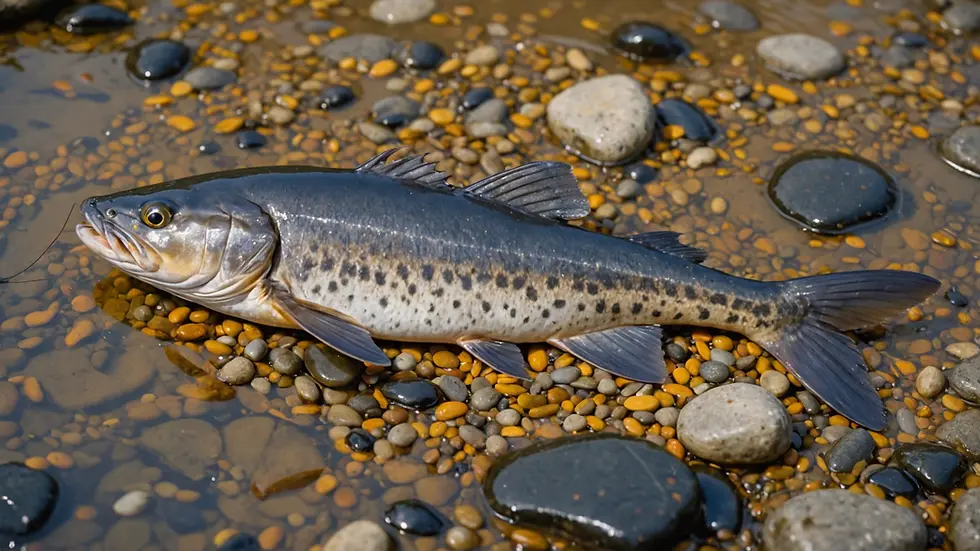Uncovering the Mysterious Behavior of Fish Playing Dead
- Jyotiraj Borah
- Feb 6
- 4 min read
Fish are captivating beings with intriguing behaviors that often perplex us. One particularly interesting behavior is when fish play dead, a response that can appear quite dramatic in the underwater realm. But what prompts certain fish to engage in this seemingly odd act? This post aims to explore the reasons behind this behavior, examining biological, ecological, and psychological factors that lead to fish playing dead.
Understanding the Behavior: Why Do Fish Play Dead?
Fish display a variety of defensive strategies to stay alive. Among these is the phenomenon known as "thanatosis," where a fish pretends to die when faced with immediate danger. When a predator is nearby, a fish that appears lifeless becomes less appealing. Predators typically seek out active prey, so a motionless fish may avoid becoming lunch.
For example, studies have shown that nearly 70% of fish species exhibit some form of this behavior, highlighting its importance in the animal kingdom. When a fish stops swimming and sinks to the bottom or lies still, it signals to predators that it may not be worth the chase.
The Science Behind Thanatosis
Playing dead involves unique physiological and neurological responses. When threatened, a fish's heart rate slows, and metabolic functions decline. This near-paralyzed state conserves energy while increasing survival odds by disguising the fish as an unappetizing option.
Certain species, such as catfish and flounders, have been documented using this technique. Experiments have shown that fish can learn to associate specific threats with danger, prompting them to play dead. These behaviors underscore the complexity behind fish instincts and awareness.
The Role of Evolution
Evolution plays a significant role in the development of thanatosis. Fish that learned to mimic death likely enjoyed better survival rates, allowing them to reproduce and pass on these advantageous traits. Over time, this behavior has become more pronounced in species vulnerable to predation.
Fish in environments with high predator densities tend to excel if they can effectively play dead. In contrast, species unable to use this tactic may see their populations decline. For instance, populations of catfish that can perform thanatosis can thrive in predator-rich areas, while rival species without this ability often struggle.
Species That Exhibit this Behavior
Not all fish can pretend to die, but several notable species are masters of this tactic:
Catfish: Some catfish species lie motionless on the river or lakebed until they feel safe to swim again. Studies have shown that these fish can remain still for up to 15 minutes when threatened.
Flounder: This fish's flat body allows it to blend seamlessly into its environment. While flat on the seafloor, a flounder can stay completely still, resembling a lifeless creature until it’s time to escape.
Pufferfish: Renowned for their ability to inflate, pufferfish can also remain completely still, effectively mimicking death to evade predators.
The effectiveness of these adaptations varies by species and is often closely linked to their respective environments and threats.
The Role of Context and Environment
The likelihood of a fish playing dead often depends on its environment. Areas with high predator concentrations make defensive measures like thanatosis crucial. On the other hand, in safe habitats, this behavior is less frequently observed.
Social dynamics can also trigger the playing-dead response. For example, if larger fish in a group show signs of alarm—like erratic swimming—smaller fish might instinctively play dead to avoid becoming a target.
Psychological Factors in Fish Behavior
Fish possess cognitive abilities that often go unnoticed. Recent studies suggest many fish experience a range of emotions, such as fear and stress. Playing dead can be an instinctual response as well as a learned behavior to environmental threats.
Fear evokes physiological changes that make fish susceptible to drastic measures, including thanatosis. Observations in aquariums have revealed that fish can learn to associate certain visual cues with danger, prompting them to mimic death in response.
The Role of Other Animals in the Ecosystem
Thanatosis is not limited to fish. Various animals, including certain amphibians, reptiles, and even mammals, use this tactic to dodge predators. This shared survival strategy across species emphasizes the importance of adaptability in the animal kingdom.
The dynamics between predator and prey influence the evolution of behaviors like playing dead. As predators adapt to overcome this tactic, prey continually refine their defenses to survive an ever-evolving landscape.
Cultural Interpretations and Symbolism
The act of fish playing dead holds various cultural meanings as well. Across different societies, fish often symbolize transformation and resilience. Their ability to feign death mirrors the human experience of overcoming obstacles.
In art and literature, fish frequently represent deeper themes, instructing us about survival and adaptability. Gaining insight into why fish play dead can enhance our appreciation of their complexity and the lessons they offer.
Conservation Implications
As our understanding of fish behavior advances, so must our conservation strategies. Recognizing that some fish engage in thanatosis can inform efforts to protect vital habitats and sustain fish populations.
Awareness of fish responses to threats could reshape fishing practices, promoting sustainable interactions with aquatic species. By grasping these behaviors, we can better safeguard fish populations and their ecosystems, encouraging biodiversity.


Embracing the Mystery
The behavior of fish playing dead is both fascinating and informative, bridging biology, ecology, and culture. Whether as a survival tactic, an evolutionary response, or a symbolic act, this phenomenon encourages us to explore the wonders of marine life deeply.
As we expand our knowledge of aquatic ecosystems, acknowledging the complexities of fish behavior can shape more effective conservation strategies. Recognizing how fish behave not only enhances our understanding but also enriches our appreciation for the incredible life residing beneath the waves.





Comments